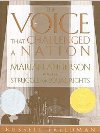|
The Voice That Challenged a Nation: Marian Anderson and the Struggle for Equal Rights

Last updated Thursday, February 24, 2011
Author: Russell Freedman
Date of Publication: 2004
ISBN: 0618159762
Grade Level: 5th (GLCs: Click here for grade level guidelines.)
Date(s) Used: Mar. 2011
Synopsis:
From School Library Journal
Grade 5-9–In the initial chapter, Freedman movingly and dramatically sets the stage for the performer's historic 1939 Easter concert at the Lincoln Memorial. In less than two pages, he captures the huge crowd's eager anticipation, briefly describes the controversy sparked by the Daughters of the American Revolution's refusal to allow Anderson to appear at Constitution Hall, and mentions the significance of the concert. He leaves readers at the moment when "A profound hush settled over the crowd.… she closed her eyes, lifted her head, clasped her hands before her, and began to sing." The author then switches to a chronological account of Anderson's life from her childhood in Philadelphia through her acclaimed U.S. and European concert tours in the 1920s and 1930s. He then gives a fuller account of the famous outdoor concert, which he refers to as a milestone in both musical and civil rights history. Freedman acknowledges that the singer did not set out to be a political activist or a crusader for civil rights. Numerous archival photographs, thorough chapter notes, a selected bibliography of works for both adult and younger readers, and a selected discography of currently available Anderson CDs are included. This inspiring work once again demonstrates Freedman's talent for showing how a person's life is molded by its historical and cultural context. Readers of Pam Muñoz Ryan's When Marian Sang (Scholastic, 2002) will appreciate this lengthier account of Anderson's life, as will all readers of biography, U.S. history, and musical history.
| Note to readers: |
| • |
Explain the historical context of the book.
|
| • |
If the kids start looking board, skip to chapter 6 after chapter 2.
|
| Discussion topics for before reading: |
| • |
When do you think this took place?
|
| • |
Do you know who Marian Anderson is?
|
| • |
What kind of music do you think Marian Anderson sings? (Opera and church hymns)
|
| • |
Do you know what civil rights are?
--Why do you think people would want to have them?
|
| • |
Do you know where the Lincoln Memorial is? Why is it special? (Show page 58)
|
| • |
Jump to page 17, 22, or 81 to show photo – how would you feel having to use separate entrances, use separate drinking fountains, etc just because of the color of your skin?
|
| • |
Can you think of any struggles for equal rights now (when people are not treated the same)?
|
| • |
Do you think every person was racists in the 1940s?
|
| Discussion topics for during/after reading: |
| • |
How much do you think $5 was worth in 1910? Answer: Approximately $175. $17 was worth about $400 in 1910.
|
| • |
What do you like doing now that you have to work hard at to get better at?
|
| • |
Why do you think a good singer would have to study how to sing? Do you think most singers take lessons?
|
| • |
Why would Marian Anderson not be allowed to sing at Constitution Hall?
|
| Craft ideas: |
| • |
Create a posted for a Marian Anderson (or other performer they like) concert.
|
*Note: These craft ideas are just suggestions.
You can use them, but you don't have to use them.
You can expand upon them, or add your own twist.
Remember, though, that the focus of your time should
not be on the development and execution of a craft;
the focus should be on the read-aloud and the
enjoyment of the book!
|
